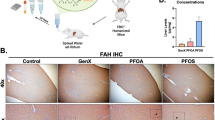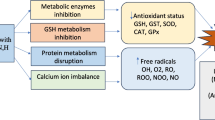Abstract
The ubiquitous presence of arsenic (a toxic metalloid) in our environment, particularly in our drinking water, is a serious health hazard of global concern. The present work deals with the assessment of arsenic toxicity through the analysis of induced sperm impairments in sperm head morphology and sperm count in mice at low exposures compared to the magnitude of response at high exposure levels. The animals were exposed to four doses of arsenic, ranging from lowest dose of 0.3 μg kg−1 day−1 (the human reference dose) to higher dose of 30 μg kg−1 day−1 for 15 consecutive days. The epididymal sperms were harvested after one spermatogenic cycle on the 36th day and were scored for the presence of any abnormality in their head morphology as well as changes in their count. Exposure to arsenic significantly induced, in a dose-dependent manner, increases in the frequency of sperms with abnormal head morphology from 5.12 % in control to 9.23 % in lowest dose group and 23.02 % in highest dose group. In contrast, the mean sperm counts in the epididymal wash were decreased from 6.05 million per milliliter in the control to 4.95 million per milliliter in the lowest dose group and 3.07 million in the highest dose group. The analysis of sperm impairments in mice was, therefore, found to be a highly sensitive assay to assess arsenic toxicity, exhibiting a marked male reprotoxic effect of arsenic even at its low exposure levels including the human reference dose.

Similar content being viewed by others
References
APHA (1998). Standard methods for the examination of water and waste water, 20th edition. American Water Work Association, American Environment Federation, Washington, DC. American Public Health Association.
Aposhian, H. V., & Aposhian, M. M. (2006). Arsenic toxicology: five questions. Chemical Research in Toxicology, 19, 1–15.
ATSDR (2007). Toxicological profile for arsenic. US Department of Health and Human Services, Atlanta, Georgia. Agency for Toxic Substances and Disease Registry.
ATSDR (2008). Medical management guidelines for arsenic trioxide (As2O3). CAS♯: 1327–53–3 UN♯:1561. Agency for Toxic Substances and Disease Registry.
Bartke, A. J., Weir, A., Mathison, P., Robertson, C., & Delterio, S. (1974). Testicular function in mouse strains with different age of sexual maturation. Journal of Heredity, 65, 204–208.
Biswas, R., Poddar, S., & Mukharjee, A. (2006). Investigations on the genotoxic effects of long term administration of sodium arsenite in bone marrow and testicular cell in vivo using comet assay. Journal of Environmental Pathology, Toxicology and Oncology, 26, 29–37.
Chang, S. I., Jin, B., Youn, P., Park, C., Park, J. D., & Ryu, D. Y. (2007). Arsenic induced toxicity and the protective role of ascorbic acid in mouse testis. Toxicology and Applied Pharmacology, 218, 196–203.
Ditton, H. J., Zimmer, J., Kamp, C., Meyts, E. R. D., & Vogt, P. H. (2004). The AZFa gene DBY (DDX3Y) is widely transcribed but the protein is limited to the male germ cells by translation control. Human Molecular Genetics, 13, 2333–2341.
Ekaluo, U. B., Ikepeme, E. V., & Udokpoh, E. A. (2009). Sperm head abnormality and mutagenic effects of aspirin, paracetamol and caffeine containing analgesics in rats. International Journal of Toxicology, 7.
Foresta, C., Ferlin, A., & Moro, E. (2000). Deletion and expression analysis of AZFa genes on the human Y chromosome revealed a major role for DBY in male infertility. Human Molecular Genetics, 9, 1161–1169.
Greco, E., Scarselli, F., Lacobelli, M., Rienzi, L., Ubaldi, F., Ferrero, S., Franco, G., Knniballo, N., Nendoza, C., & Tesarik, J. (2005). Efficient treatment of infertility due to sperm DNA damage by ICSI with testicular spermatozoa. Human Reproduction, 20, 226–230.
IARC (2004). IARC monograph on the evaluation of the carcinogenic risk to humans (vol 84): some drinking water disinfectants and contaminants, including arsenic. IARC, Lyon, France. International Agency for Research on Cancer.
Jana, K., Jana, S., & Samanta, P. K. (2006). Effects of chronic exposure to sodium arsenite on hypothalamo-pituitary-testicular activities in adult rats: possible an estrogenic mode of action. Reproductive Biology and Endocrinology, 16, 4–9.
Kar, S., Maity, J. P., Jean, J.-S., Liu, C.-C., Nath, B., Yang, H.-J., & Bundschuh, J. (2010). Arsenic enriched aquifers: occurrences and mobilization of arsenic in groundwater of Ganges Delta Plain, Barasat, West Bengal, India. Applied Geochemistry, 25, 1804–1814.
Kesari, V. P., Kumar, A., & Khan, P. K. (2012). Genotoxic potential of arsenic at its reference dose. Ecotoxicology and Environmental Safety, 80, 126–131.
Khan, P. K., & Sinha, S. P. (1996). Ameliorating effect of vitamin C on murine sperm toxicity induced by three pesticides (endosulfan, phosphamidon and mancozab). Mutagenesis, 11, 33–36.
Khan, P. K., Kesari, V. P., & Kumar, A. (2013). Mouse micronucleus assay as a surrogate to assess genotoxic potential of arsenic at its human reference dose. Chemosphere, 90, 993–997.
Kitchin, K. T., & Conolly, R. (2010). Arsenic-induced carcinogenesis—oxidative stress as a possible mode of action and future research needs for more biologically based risk assessment. Chemical Research in Toxicology, 23, 327–335.
Kleiman, S. E., Yogev, L., Hauser, R., Botchem, A., Maymon, B. B. S., Paz, G., & Yavetz, H. (2007). Expression profile of AZF genes in testicular biopsies of azoospermic men. Human Reproduction, 22, 151–158.
Lardone, M. C., Parodi, D. A., Valdevenito, R., Ebensperger, M., Piottante, A., Madariaga, M., Smith, R., Pommer, R., Zambrano, N., & Castro, A. (2007). Quantification of DDX3Y, RBMY1, DAZ and TSPY mRnas in testis of patients with severe impairment of spermatogenesis. Molecular Human Reproduction, 13, 705–712.
Lewis-Jones, I., Aziz, N., Seshadri, S., Douglas, A., & Howard, P. (2003). Sperm chromosomal abnormalities are linked to sperm morphological deformities. Fertility and Sterility, 79, 212–215.
Li, Y., Wang, M., Piao, F., & Wang, X. (2012). Subchronic exposure to arsenic inhibits spermatogenesis and downregulates the expression of Ddx3y in testis and epididymis of mice. Toxicological Sciences, 128, 482–489.
Lubin, J. H., Beane, F. L. E., & Cantor, K. P. (2007). Inorganic arsenic in drinking water: an evolving public health concern. Journal of National Cancer Institute, 99, 906–907.
Luddi, A., Margollicci, M., Gambera, L., Serafini, F., Cioni, M., De Leo, V., Balestri, P., & Piomboni, P. (2009). Spermatogenesis in a man with complete deletion of USP9Y. New England Journal of Medicine, 360, 881–885.
Marcon, L., & Boissonneault, G. (2004). Transient DNA strand breaks during mouse and human spermatogenesis: new insights in stage specific and link to chromatin remodelling. Biology of Reproduction, 70, 910–918.
Martin, R. H., Rademaker, A. W., Greene, C., Ko, E., Hoang, T., Barclay, L., & Chernos, J. (2003). Comparison of the frequency of sperm chromosome abnormalities in men with mild, moderate and severe oligozoospermia. Biology of Reproduction, 69, 535–539.
Mazeyrat, S., Saut, N., Sargent, C. A., Grimmond, S., Longepied, G., Ehrmann, I. E., Ellis, P. S., Greenfield, A., Affara, N. A., & Mitchefl, M. J. (1998). The mouse Y chromosome interval necessary for spermatogonial proliferation is gene dense with synthetic homology to the human AZFa region. Human Molecular Genetics, 7, 1713–1724.
Meeker, J. D., Rossano, M. G., Protas, B., Padmanahban, V., Diamon, M. P., Puscheck, E., Daly, D., Paneth, N., & Wirth, J. J. (2010). Environmental exposure to metals and male reproductive hormones: circulating testosterone is inversely associated with blood molybdenum. Fertility and Sterility, 93, 130–140.
Meistrich, M. L. (1993). Potential genetic risks of using semen collected during chemotherapy. Human Reproduction, 8, 8–10.
Nei, J. S., Pei, Q. L., Han, G., Xu, J. X., & Mu, J. J. (2006). Semen quality decreased by inorganic arsenic. Journal of Environmental and Occupational Medicine, 23, 189–190.
Nordstrom, D. K. (2002). Worldwide occurrence of arsenic in groundwater. Science, 296, 2143–2145.
Ollero, M., Gil-Guzman, E., Lopez, M. C., Sharma, R. K., Agarwal, A., Larson, K., Evenson, D., Thomas, A. J., & Alvarez, J. C. (2001). Characterization of subset of human spermatozoa at different steps of maturation: implementations in the diagnosis and treatment of male infertility. Human Reproduction, 16, 1912–1921.
Pant, N., Murty, R. C., & Srivastava, S. P. (2004). Male reproductive toxicity of sodium arsenite in mice. Human and Experimental Toxicology, 23, 399–403.
Sanghmitra, S., Hajara, J., Upadhyay, S. N., Singh, R. K., & Amal, R. C. (2008). Arsenic induced toxicity on testicular tissue of mice. Indian Journal of Physiology and Pharmacology, 52, 84–90.
Sikka, S. C. (2004). Role of oxidative stress and antioxidants in andrology and assisted reproductive technology. Asian Journal of Andrology, 6, 139–148.
USEPA (2001). Arsenic, Integrated Risk Information System (IRIS, the USEPA online chemical toxicity information service), United States Environmental Protection Agency.
van Halem, D., Bakker, S. A., Amy, G. L., & van Dijk, J. C. (2009). Arsenic in drinking water: a worldwide water quality concern for water supply companies. Drinking Water Engineering Sciences, 2, 29–34.
Veeramachaneni, D. N. R., Palmer, J. S., & Aman, R. P. A. (2001). Long term effects on male reproduction of early exposure to common chemical contaminants in drinking water. Reproduction, 10, 979–980.
Vegetti, W., Van Assche, E., Frias, A., Verheyen, G., Bianchi, M. M., Bonduelle, M., Liebaers, I., & Van Steirteghem, A. (2000). Correlation between semen parameters and sperm aneuploidy rates investigated by fluorescence in-situ hybridization in fertile men. Human Reproduction, 15, 351–365.
Viville, S., Morrald, R., Bach, M. L., Falquet, C., Gerlinger, P., & Warter, S. (2000). Do morphological anomalies reflect chromosomal aneuploides? Human Reproduction, 15, 2563–2566.
Vogt, P. H., Edelmann, A., Kirsch, S., Henegariu, O., Hirschmann, P., Kiesewetter, F., Kohn, F. M., Schill, W. B., Farah, S., Ramos, C., Hartmann, M., Hartschuh, W., Meschede, D., Behre, H. M., Castel, A., Nieschlag, E., Weidner, W., Grone, H. J., Jung, A., Engle, W., & Haidl, G. (1996). Human Y chromosome azoospermia factor (AZF) mapped to different subregions in Yq11. Human Molecular Genetics, 5, 933–943.
Vong, Q. P., Li, Y., Lau, Y. F., Dym, M., Rennert, O. M., & Chan, W. Y. (2006). Structural characterization and expression studies of Dby and its homologs in the mouse. Journal of Andrology, 27, 653–661.
Wyrobek, A. J., Gordon, L. A., Burkhart, J. G., Francis, M. W., Kapp, R. W., Letz, G., Malling, H. V., Tophan, J. C., & Whorton, M. D. (1983). An evaluation of the mouse sperm morphology test and other sperm tests in non-human animals. A report of the US Environmental Protection Agency Gene-Tox Program. Mutation Research, 115, 1–72.
Wyrobek, A. J., Watchmarker, G., & Gordon, L. (1984). Sperm morphology testing in mice. In B. J. Killbey, M. Legator, M. Nichols, & C. Ramel (Eds.), Handbook of Mutagenicity Test Procedures (2nd ed., pp. 739–750). Amsterdam: Elsevier.
Author information
Authors and Affiliations
Corresponding author
Rights and permissions
About this article
Cite this article
Kesari, V.P., Kumar, A. & Khan, P.K. Induction of sperm impairments in mice as a sensitive biomarker of arsenic toxicity. Environ Monit Assess 186, 3115–3121 (2014). https://doi.org/10.1007/s10661-013-3604-6
Received:
Accepted:
Published:
Issue Date:
DOI: https://doi.org/10.1007/s10661-013-3604-6




